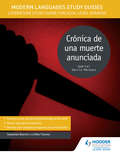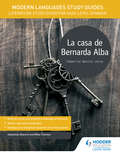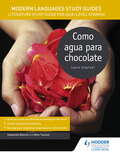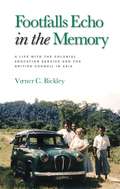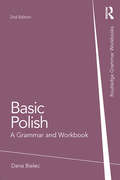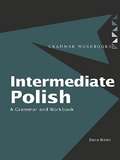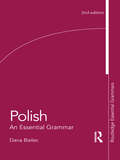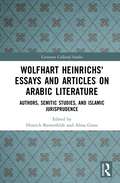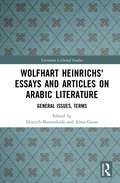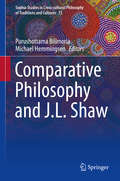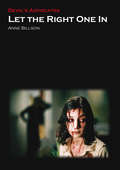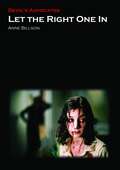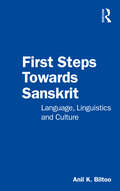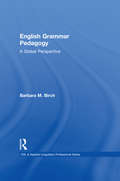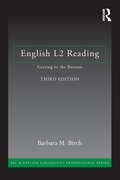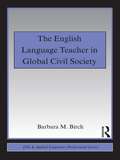- Table View
- List View
Modern Languages Study Guides: Literature Study Guide for AS/A-level Spanish (Film and literature guides)
by Sebastian Bianchi Mike ThackerLiterature analysis made easy. Build your students' confidence in their language abilities and help them develop the skills needed to critique their chosen work: putting it into context, understanding the themes and narrative technique, as well as specialist terminology.Breaking down each scene, character and theme in Crónica de una muerte anunciada, this accessible guide will enable your students to understand the historical and social context of the novel and give them the critical and language skills needed to write a successful essay.- Strengthen language skills with relevant grammar, vocab and writing exercises throughout- Aim for top marks by building a bank of textual examples and quotes to enhance exam response- Build confidence with knowledge-check questions at the end of every chapter- Revise effectively with pages of essential vocabulary and key mind maps throughout- Feel prepared for exams with advice on how to write an essay, plus sample essay questions, two levels of model answers and examiner commentary
Modern Languages Study Guides: Literature Study Guide for AS/A-level Spanish (Film and literature guides)
by Sebastian Bianchi Mike ThackerLiterature analysis made easy. Build your students' confidence in their language abilities and help them develop the skills needed to critique their chosen work: putting it into context, understanding the themes and narrative technique, as well as specialist terminology.Breaking down each scene, character and theme in La casa de Bernarda Alba, this accessible guide will enable your students to understand the historical and social context of the play and give them the critical and language skills needed to write a successful essay.- Strengthen language skills with relevant grammar, vocab and writing exercises throughout- Aim for top marks by building a bank of textual examples and quotes to enhance exam response- Build confidence with knowledge-check questions at the end of every chapter- Revise effectively with pages of essential vocabulary and key mind maps throughout- Feel prepared for exams with advice on how to write an essay, plus sample essay questions, two levels of model answers and examiner commentary
Modern Languages Study Guides: Literature Study Guide for AS/A-level Spanish (Film and literature guides)
by Sebastian Bianchi Mike ThackerExam Board: AQA, Edexcel, WJEC, Eduqas & CCEALevel: AS/A-levelSubject: Modern LanguagesFirst Teaching: September 2017First Exam: June 2018Literature analysis made easy. Build your students' confidence in their language abilities and help them develop the skills needed to critique their chosen work: putting it into context, understanding the themes and narrative technique, as well as specialist terminology.Breaking down each scene, character and theme in Como agua para chocolate (Like Water for Chocolate), this accessible guide will enable your students to understand the historical and social context of the novel and give them the critical and language skills needed to write a successful essay.- Strengthen language skills with relevant grammar, vocab and writing exercises throughout- Aim for top marks by building a bank of textual examples and quotes to enhance exam response- Build confidence with knowledge-check questions at the end of every chapter- Revise effectively with pages of essential vocabulary and key mind maps throughout- Feel prepared for exams with advice on how to write an essay, plus sample essay questions, two levels of model answers and examiner commentary
Footfalls Echo in the Memory: A Life with the Colonial Education Service and the British Council in Asia
by Verner C. BickleyThe Education Service was a vital arm of the British Colonial Service while the British Council has been paramount in promoting the English language and culture overseas. But are both agents of British colonialism and neo-colonialism? Or are both simply altruistic purveyors of language and culture to a wider world?Verner Bickley as an Education Officer in the British Colonial Service and in the British Council provides the answer and shows that educational and cultural values were paramount and important in themselves, and through the medium of the near-global English language, vitally important in both culture and technical training. Life in overseas postings was set against a backdrop of turbulent international relations following World War II, including service in the Royal Navy in India and Ceylon, soon to be become independent Sri Lanka. Bickley was Education Officer in Singapore during the tumultuous 1950s, at the time of the Malayan 'Emergency' and in the lead-up to independence in 1957 which he announced on Radio Malaya. His service with the British Council began with a posting to Burma during the premiership of U Nu, struggling with ethnic problems and to be ousted by military coup. And during his time in Indonesia the British Embassy was burnt to the ground by rioters. Later service was in Japan - basking in its success as an emerging economic powerhouse. This is an essentially warm and human story enlivened, especially during the British Council period, by a succession of diverse personalities, including royalty, British and Thai, as well as writers like Anthony Burgess, Graham Greene and Willis Hall and actors such as Donald Sinden, Patrick Stewart and Max Adrian.
Basic Polish: A Grammar and Workbook
by Dana BielecBasic Polish presents concise explanations of grammar with related exercises, to build confidence in using the modern language. Assuming no previous knowledge of Polish, the book’s step-by-step approach guarantees a thorough grounding in the basics of grammar. Each of the forty units introduces particular grammar points. Clear and concise explanations are supported by a wide range of examples and exercises to allow students to practise and consolidate their learning. Later units also reinforce material taught in earlier ones. Key features include: clear, accessible format many useful language examples jargon-free explanations of grammar abundant exercises with a full answer key notes on the Polish alphabet, pronunciation and stress Polish-English vocabulary subject index. This second edition has been revised to include updated examples and explanations. It also offers five new appendices containing a comprehensive summary of grammar functions, guidance on studying an inflected language, and helpful information on question words, the important verbs by? and mie? and perfective and imperfective verb aspects. Written by an experienced language teacher and author, Basic Polish is the ideal introduction to the structures and expressions most widely used in spoken and written Polish. It is suitable for both independent use and classroom study.
Basic Polish: A Grammar and Workbook
by Dana BielecBasic Polish presents concise explanations of grammar with related exercises, to build confidence in using the modern language. Assuming no previous knowledge of Polish, the book’s step-by-step approach guarantees a thorough grounding in the basics of grammar. Each of the forty units introduces particular grammar points. Clear and concise explanations are supported by a wide range of examples and exercises to allow students to practise and consolidate their learning. Later units also reinforce material taught in earlier ones. Key features include: clear, accessible format many useful language examples jargon-free explanations of grammar abundant exercises with a full answer key notes on the Polish alphabet, pronunciation and stress Polish-English vocabulary subject index. This second edition has been revised to include updated examples and explanations. It also offers five new appendices containing a comprehensive summary of grammar functions, guidance on studying an inflected language, and helpful information on question words, the important verbs by? and mie? and perfective and imperfective verb aspects. Written by an experienced language teacher and author, Basic Polish is the ideal introduction to the structures and expressions most widely used in spoken and written Polish. It is suitable for both independent use and classroom study.
Intermediate Polish: A Grammar and Workbook (Grammar Workbooks)
by Dana BielecIntermediate Polish is designed for learners who have achieved basic proficiency and wish to progress to more complex language. Each unit combines clear, concise grammar explanations with examples and exercises to help build confidence and fluency.Features include:* focus on areas of particular confusion such as verbs that are difficult to translate and nouns made from numbers * comprehensive glossary of grammatical terms* reference list of over 250 Polish verbs* full key to all exercises.Suitable for independent learners and students on taught courses, Intermediate Polish, together with its sister volume, Basic Polish, forms a structured course in the essentials of Polish.Dana Bielec is the author of the popular Polish: An Essential Grammar, as well as Basic Polish: A Grammar and Workbook, both published by Routledge.
Intermediate Polish: A Grammar and Workbook (Grammar Workbooks)
by Dana BielecIntermediate Polish is designed for learners who have achieved basic proficiency and wish to progress to more complex language. Each unit combines clear, concise grammar explanations with examples and exercises to help build confidence and fluency.Features include:* focus on areas of particular confusion such as verbs that are difficult to translate and nouns made from numbers * comprehensive glossary of grammatical terms* reference list of over 250 Polish verbs* full key to all exercises.Suitable for independent learners and students on taught courses, Intermediate Polish, together with its sister volume, Basic Polish, forms a structured course in the essentials of Polish.Dana Bielec is the author of the popular Polish: An Essential Grammar, as well as Basic Polish: A Grammar and Workbook, both published by Routledge.
Polish: An Essential Grammar
by Dana BielecPolish: An Essential Grammar is a user-friendly guide to all the important structures of this fascinating language. Presenting a fresh and accessible description of the language, this engaging grammar uses clear, jargon-free explanations and sets out the complexities of Polish in short, readable sections. Key features include: New chapter on studying an inflected language, including detailed analysis of a typical text Comprehensive descriptions of the parts of speech covered Information presented clearly and logically in table form Wealth of real-life examples Nine clearly-presented appendices. This grammar is an invaluable asset to anyone wishing to master the Polish language as it is spoken today. Two companion books, Basic Polish: A Grammar and Workbook and Intermediate Polish: A Grammar and Workbook, provide more detailed practice in the language.
Polish: An Essential Grammar
by Dana BielecPolish: An Essential Grammar is a user-friendly guide to all the important structures of this fascinating language. Presenting a fresh and accessible description of the language, this engaging grammar uses clear, jargon-free explanations and sets out the complexities of Polish in short, readable sections. Key features include: New chapter on studying an inflected language, including detailed analysis of a typical text Comprehensive descriptions of the parts of speech covered Information presented clearly and logically in table form Wealth of real-life examples Nine clearly-presented appendices. This grammar is an invaluable asset to anyone wishing to master the Polish language as it is spoken today. Two companion books, Basic Polish: A Grammar and Workbook and Intermediate Polish: A Grammar and Workbook, provide more detailed practice in the language.
Wolfhart Heinrichsʼ Essays and Articles on Arabic Literature: Authors, Semitic Studies, and Islamic Jurisprudence (Variorum Collected Studies)
by Hinrich Biesterfeldt Alma GieseWolfhart Heinrichs’ Essays and Articles on Arabic Literature: Authors, Semitic Studies, and Islamic Jurisprudence is the second of two volumes that showcase a great number of Heinrichs’ writings on Arabic literature, Semitic Studies, and Islamic jurisprudence.Wolfhart Heinrichs (1941-2014) was James Richard Jewett Professor of Arabic at Harvard University. He is remembered as a significant adviser to Fuat Sezginʼs fundamental Geschichte des arabischen Schrifttums; as an editor of and contributor to the Encyclopaedia of Islam, Second edition; and, most importantly, as an author of many independent studies on Arabic literature, many of which were groundbreaking in the history of Arabic philology. He is also known for his studies on Semitic linguistics and Islamic jurisprudence.This volume collects relevant bibliographical data, offers an introductory essay on the author by his distinguished student Michael Cooperson (UCLA), and presents reprints of his articles and essays. These include the remainder of Heinrichsʼ contributions to Arabic literature, dealing with a number of classical Arabic authors, Semitic studies in general (among them Aramaic and Neo-Aramaic), and Rhetoric as used in Islamic jurisprudence and in the game of scholarly debate (jadal). An index of classical authors, book titles, and technical terms concludes the volume.This volume and its companion will appeal to students and researchers in the fields of Arabic literature, Semitic Studies, and Islamic jurisprudence.
Wolfhart Heinrichs´ Essays and Articles on Arabic Literature: General Issues, Terms (Variorum Collected Studies)
by Hinrich Biesterfeldt Alma GieseWolfhart Heinrichs’ Essays and Articles on Arabic Literature: General Issues, Terms is the first of two volumes that showcase a great number of Heinrichsʼ writings on his central field of research: Arabic literature. This volume specifically looks at poetry and rhetoric, and their indigenous theories and terminologies.Wolfhart Heinrichs (1941-2014) was James Richard Jewett Professor of Arabic at Harvard University. He is remembered as a significant adviser to Fuat Sezginʼs fundamental Geschichte des arabischen Schrifttums; as an editor of and contributor to the Encyclopaedia of Islam, Second edition; and, most importantly, as an author of many independent studies on Arabic literature, many which were groundbreaking in the history of Arabic philology. He is also known for his studies on Semitic linguistics and Islamic jurisprudence.This volume collects relevant bibliographical data, offers an introductory essay on the author by his distinguished student Michael Cooperson (UCLA), and provides a selection of Wolfhart Heinrichs’ essays. The articles in this volume deal with general issues in the field that are central to pre-modern Arab and Islamic culture, and their concepts and terminologies. An index of classical authors, book titles, and technical terms concludes the volume.This volume and the accompanying volume will appeal to students and researchers in the field of Arabic and Islamic Studies, and particularly to those interested in Arabic literature.
Wolfhart Heinrichs´ Essays and Articles on Arabic Literature: General Issues, Terms (Variorum Collected Studies)
by Hinrich Biesterfeldt Alma GieseWolfhart Heinrichs’ Essays and Articles on Arabic Literature: General Issues, Terms is the first of two volumes that showcase a great number of Heinrichsʼ writings on his central field of research: Arabic literature. This volume specifically looks at poetry and rhetoric, and their indigenous theories and terminologies.Wolfhart Heinrichs (1941-2014) was James Richard Jewett Professor of Arabic at Harvard University. He is remembered as a significant adviser to Fuat Sezginʼs fundamental Geschichte des arabischen Schrifttums; as an editor of and contributor to the Encyclopaedia of Islam, Second edition; and, most importantly, as an author of many independent studies on Arabic literature, many which were groundbreaking in the history of Arabic philology. He is also known for his studies on Semitic linguistics and Islamic jurisprudence.This volume collects relevant bibliographical data, offers an introductory essay on the author by his distinguished student Michael Cooperson (UCLA), and provides a selection of Wolfhart Heinrichs’ essays. The articles in this volume deal with general issues in the field that are central to pre-modern Arab and Islamic culture, and their concepts and terminologies. An index of classical authors, book titles, and technical terms concludes the volume.This volume and the accompanying volume will appeal to students and researchers in the field of Arabic and Islamic Studies, and particularly to those interested in Arabic literature.
Wolfhart Heinrichsʼ Essays and Articles on Arabic Literature: Authors, Semitic Studies, and Islamic Jurisprudence (Variorum Collected Studies)
by Hinrich Biesterfeldt Alma GieseWolfhart Heinrichs’ Essays and Articles on Arabic Literature: Authors, Semitic Studies, and Islamic Jurisprudence is the second of two volumes that showcase a great number of Heinrichs’ writings on Arabic literature, Semitic Studies, and Islamic jurisprudence.Wolfhart Heinrichs (1941-2014) was James Richard Jewett Professor of Arabic at Harvard University. He is remembered as a significant adviser to Fuat Sezginʼs fundamental Geschichte des arabischen Schrifttums; as an editor of and contributor to the Encyclopaedia of Islam, Second edition; and, most importantly, as an author of many independent studies on Arabic literature, many of which were groundbreaking in the history of Arabic philology. He is also known for his studies on Semitic linguistics and Islamic jurisprudence.This volume collects relevant bibliographical data, offers an introductory essay on the author by his distinguished student Michael Cooperson (UCLA), and presents reprints of his articles and essays. These include the remainder of Heinrichsʼ contributions to Arabic literature, dealing with a number of classical Arabic authors, Semitic studies in general (among them Aramaic and Neo-Aramaic), and Rhetoric as used in Islamic jurisprudence and in the game of scholarly debate (jadal). An index of classical authors, book titles, and technical terms concludes the volume.This volume and its companion will appeal to students and researchers in the fields of Arabic literature, Semitic Studies, and Islamic jurisprudence.
Comparative Philosophy and J.L. Shaw (Sophia Studies in Cross-cultural Philosophy of Traditions and Cultures #13)
by Purushottama Bilimoria Michael HemmingsenAs a Festschrift, this book celebrates and honours the scholarly achievements of Professor Jaysankar Lal Shaw, one of the most eminent and internationally acclaimed comparative philosophers of our times. Original works by leading international philosophers and logicians are presented here, exploring themes such as: meaning, negation, perception and Indian and Buddhist systems of philosophy, especially Nyaya perspectives.Professor Shaw’s untiring effort to solve some of the problems of contemporary philosophy of language, logic, epistemology, metaphysics and morals from the perspectives of classical Indian philosophers or systems of philosophy is deserving of a tribute. Chapters in this volume reflect the diverse aspects of Shaw’s contribution to comparative philosophy and are organised into four sections: Language, Epistemology, Mathematics and Logic, Ethics and Politics.These chapters would appeal to anyone interested in philosophy or East-West thinking, including students and professionals. Graduates and researchers with interests in epistemology, metaphysics, political philosophy, logic and non-western philosophy will find this work highly relevant.Regarding the editors, Purushottama Bilimoria is a honorary professor at Deakin University and research fellow at the University of Melbourne in Australia, a Visiting Professor and Lecturer at University of California, Berkeley and Graduate Theological Union; Michael Hemmingsen is a PhD Candidate in the Department of Philosophy at McMaster University, Ontario, Canada.
Let the Right One In (Devil's Advocates)
by Anne BillsonThese days it takes a very special vampire movie to stand out. Like Twilight, the Swedish film Let the Right One In is a love story between a human and a vampire but there the resemblance ends. Let the Right One In is not a romantic fantasy but combines the supernatural with social realism. Set on a housing estate in the suburbs of Stockholm in the early 1980s, it's the story of Oskar, a lonely, bullied child, who makes friends with Eli, the girl in the next apartment. 'Oskar, I'm not a girl,' she tells him and she's not kidding. They forge a relationship which is oddly innocent yet disturbing, two outsiders against the rest of the world. But one of these outsiders is, effectively, a serial killer. While Let the Right One In is startlingly original, it nevertheless couldn't have existed without the near century of vampire cinema that preceded it. Acclaimed film critic and horror novelist Anne Billson looks at how it has drawn from, and wrung new twists on, such classics as Nosferatu (1922), how vampire cinema has already flirted with social realism in films like Near Dark (1987) and how vampire mythology adapts itself to the modern world.
Let the Right One In (Devil's Advocates)
by Anne BillsonThese days it takes a very special vampire movie to stand out. Like Twilight, the Swedish film Let the Right One In is a love story between a human and a vampire but there the resemblance ends. Let the Right One In is not a romantic fantasy but combines the supernatural with social realism. Set on a housing estate in the suburbs of Stockholm in the early 1980s, it's the story of Oskar, a lonely, bullied child, who makes friends with Eli, the girl in the next apartment. 'Oskar, I'm not a girl,' she tells him and she's not kidding. They forge a relationship which is oddly innocent yet disturbing, two outsiders against the rest of the world. But one of these outsiders is, effectively, a serial killer. While Let the Right One In is startlingly original, it nevertheless couldn't have existed without the near century of vampire cinema that preceded it. Acclaimed film critic and horror novelist Anne Billson looks at how it has drawn from, and wrung new twists on, such classics as Nosferatu (1922), how vampire cinema has already flirted with social realism in films like Near Dark (1987) and how vampire mythology adapts itself to the modern world.
First Steps Towards Sanskrit: Language, Linguistics and Culture
by Anil K. BiltooFirst Steps Towards Sanskrit: Language, Linguistics and Culture is an accessible first introduction to this ancient Indian language. Complete beginners are introduced to the language from scratch. Key terms are explained clearly and there is an extensive glossary to assist the reader who is unfamiliar with the terminology of language learning. By the end of the book, learners will have grasped the basics of the language and be prepared to engage readily in an introductory college or university course or through private study. The addition of cultural, linguistic and historical notes will appeal to learners with diverse interests, ranging from religious studies and philosophy to yoga and comparative or historical linguistics. The book includes references to classical and modern European languages. Parallels are also drawn with Indic languages where these are relevant, particularly as concerns the writing system. No knowledge of any language other than English is, however, presupposed. This book is ideal for both self-study and in-class use as a primer or core text for pre-sessional courses.
First Steps Towards Sanskrit: Language, Linguistics and Culture
by Anil K. BiltooFirst Steps Towards Sanskrit: Language, Linguistics and Culture is an accessible first introduction to this ancient Indian language. Complete beginners are introduced to the language from scratch. Key terms are explained clearly and there is an extensive glossary to assist the reader who is unfamiliar with the terminology of language learning. By the end of the book, learners will have grasped the basics of the language and be prepared to engage readily in an introductory college or university course or through private study. The addition of cultural, linguistic and historical notes will appeal to learners with diverse interests, ranging from religious studies and philosophy to yoga and comparative or historical linguistics. The book includes references to classical and modern European languages. Parallels are also drawn with Indic languages where these are relevant, particularly as concerns the writing system. No knowledge of any language other than English is, however, presupposed. This book is ideal for both self-study and in-class use as a primer or core text for pre-sessional courses.
English Grammar Pedagogy: A Global Perspective
by Barbara M. BirchDesigned for ESL and ELT pedagogy courses around the world, this text describes English grammar from a World Englishes perspective. It is distinguished by its focus on the social setting for English as a global language, the latest thinking about grammatical theory, and new theories of how first and second languages are learned and taught. The fundamental premise is that teaching and learning grammar cannot be isolated from the local, regional, and global sociocultural contexts in which the teaching and learning take place. Part I presents different attitudes toward English as a global language and some challenges that learners of English share no matter where they are in the world. Part II is about the features of English that educated speakers consider the most likely and probable in Academic English. Part III describes the flexible and fluid features of English that might be susceptible to change or modification over time. Each chapter includes engaging Study, Discussion, and Essay Questions and Activities.
English Grammar Pedagogy: A Global Perspective
by Barbara M. BirchDesigned for ESL and ELT pedagogy courses around the world, this text describes English grammar from a World Englishes perspective. It is distinguished by its focus on the social setting for English as a global language, the latest thinking about grammatical theory, and new theories of how first and second languages are learned and taught. The fundamental premise is that teaching and learning grammar cannot be isolated from the local, regional, and global sociocultural contexts in which the teaching and learning take place. Part I presents different attitudes toward English as a global language and some challenges that learners of English share no matter where they are in the world. Part II is about the features of English that educated speakers consider the most likely and probable in Academic English. Part III describes the flexible and fluid features of English that might be susceptible to change or modification over time. Each chapter includes engaging Study, Discussion, and Essay Questions and Activities.
English L2 Reading: Getting to the Bottom
by Barbara M. BirchEnglish L2 Reading, Third Edition offers teachers research-based insights into bottom-up skills in reading English as a second language and a solid foundation on which to build reading instruction. Core linguistic and psycholinguistic concepts are presented within the context of their application to teaching. The goal is to balance or supplement (not replace) top-down approaches and methodologies with effective low-level options for teaching English reading. The text’s pedagogical features— Questions, Study Guide Questions. Discussion Questions, Spotlight on Teaching sections— engage readers of the text in moving easily from linguistic details and psycholinguistic data and theory to practical explanations and suggestions for teaching. Two Appendices provide tables that list the graphemes or the phonemes of English. Changes in the Third Edition Shift in focus from criticism of whole language methodologies to a more neutral stance —times have changed and the study of lower-level reading strategies is now mainstream Greater focus on linguistic form, along with function and meaning Updated information about reading strategies at each level of the reading process More Spotlight on Teaching sections, one for each chapter New chapter on spelling development
English L2 Reading: Getting to the Bottom
by Barbara M. BirchEnglish L2 Reading, Third Edition offers teachers research-based insights into bottom-up skills in reading English as a second language and a solid foundation on which to build reading instruction. Core linguistic and psycholinguistic concepts are presented within the context of their application to teaching. The goal is to balance or supplement (not replace) top-down approaches and methodologies with effective low-level options for teaching English reading. The text’s pedagogical features— Questions, Study Guide Questions. Discussion Questions, Spotlight on Teaching sections— engage readers of the text in moving easily from linguistic details and psycholinguistic data and theory to practical explanations and suggestions for teaching. Two Appendices provide tables that list the graphemes or the phonemes of English. Changes in the Third Edition Shift in focus from criticism of whole language methodologies to a more neutral stance —times have changed and the study of lower-level reading strategies is now mainstream Greater focus on linguistic form, along with function and meaning Updated information about reading strategies at each level of the reading process More Spotlight on Teaching sections, one for each chapter New chapter on spelling development
The English Language Teacher in Global Civil Society (ESL & Applied Linguistics Professional Series)
by Barbara M. BirchHow can English language teachers contribute to peace locally and globally? English language teachers and learners are located in the global civil society – an international network of civil organizations and NGOs related to human rights, the environment, and sustainable peace. English, with its special role as an international language, is a major tool for communication within this network. On the local level, many teachers are interested in promoting reconciliation and sustainable peace, but often do not know how to do so. This book provides information, analysis, and techniques to help teachers around the world take action toward this goal. Balancing, in a readable and accessible way, the global and the local, core and periphery, cultural diffusion and resistance, theory and practice, pessimism and optimism, outsider and insider perspectives, the expert role and the apprentice role, and prescriptive and elicitive methods, it offers an alternative to literature about critical applied linguistics, globalization, and peace education that is simply too complex and wordy to spread easily from theoretician to the classroom teacher. The English Teacher in Global Civil Society: synthesizes threads from many fields and topics into a coherent and empowering argument for the activist role English language teachers can take to promote social change draws on humanistic education, peace education, cross-cultural understanding, problem-posing, cooperative learning, and critical thinking methodologies to help English language teachers learn how to teach conflict resolution skills in their classrooms covers issues in critical applied linguistics, approaches and methodologies in ESL/EFL, global and local curricular issues, and specific skill areas such reading, writing, and speaking suggests a new goal for English language teachers: global citizenship. This engaging, informative, provocative, and highly readable book is a welcome resource for English language teacher trainers, pre-service teachers, practicing classroom teachers, and Peace Corps workers around the world.
The English Language Teacher in Global Civil Society (ESL & Applied Linguistics Professional Series)
by Barbara M. BirchHow can English language teachers contribute to peace locally and globally? English language teachers and learners are located in the global civil society – an international network of civil organizations and NGOs related to human rights, the environment, and sustainable peace. English, with its special role as an international language, is a major tool for communication within this network. On the local level, many teachers are interested in promoting reconciliation and sustainable peace, but often do not know how to do so. This book provides information, analysis, and techniques to help teachers around the world take action toward this goal. Balancing, in a readable and accessible way, the global and the local, core and periphery, cultural diffusion and resistance, theory and practice, pessimism and optimism, outsider and insider perspectives, the expert role and the apprentice role, and prescriptive and elicitive methods, it offers an alternative to literature about critical applied linguistics, globalization, and peace education that is simply too complex and wordy to spread easily from theoretician to the classroom teacher. The English Teacher in Global Civil Society: synthesizes threads from many fields and topics into a coherent and empowering argument for the activist role English language teachers can take to promote social change draws on humanistic education, peace education, cross-cultural understanding, problem-posing, cooperative learning, and critical thinking methodologies to help English language teachers learn how to teach conflict resolution skills in their classrooms covers issues in critical applied linguistics, approaches and methodologies in ESL/EFL, global and local curricular issues, and specific skill areas such reading, writing, and speaking suggests a new goal for English language teachers: global citizenship. This engaging, informative, provocative, and highly readable book is a welcome resource for English language teacher trainers, pre-service teachers, practicing classroom teachers, and Peace Corps workers around the world.
